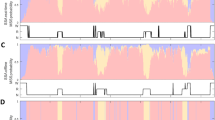Abstract
Due to improper lifestyle, sleep disorders are becoming increasingly common worldwide. Early detection may help in preventing diseases arising due to sleep disorders, such as insomnia, muscle loss, breathing, and cardiac disorders. In this paper, nocturnal human sounds are analysed to develop a personal sleep monitoring system. Multiple audio-related features are extracted from the spectrograms of sleep sounds and analysed for discriminatory ability. The selected features are given as input to a fully-connected Artificial Neural Network (ANN) to classify the sleep sounds. The proposed approach classifies the considered seven categories of sleep sounds, including coughing, laughing, screaming, sneezing, snoring, sniffling, and farting, with an average accuracy of 97.4%. This is significantly higher than the classification accuracy obtained by applying conventional machine learning models on the selected features. This indicates that the ANN learns new features to enhance the classification accuracy of the sleep sounds. Moreover, the computational requirement of the system is kept low by reducing the number of features given as input to the ANN classifier. The proposed approach may be integrated with a smartphone or a cloud platform to develop a device for sleep monitoring or diagnosis of sleep disorders.







Similar content being viewed by others
Data availability
Publicly available data was used in this research work as mentioned in Section 3.1.
References
Adesuyi TA, Kim BM, Kim J (2022) Snoring sound classification using 1D-CNN model based on multi-feature extraction. Int J Fuzzy Logic Intell Syst 22(1):1–10. https://doi.org/10.5391/IJFIS.2022.22.1.1
Akbal E, Tuncer T (2021) FusedTSNet: An automated nocturnal sleep sound classification method based on a fused textural and statistical feature generation network. Appl Acoust 171:107559. https://doi.org/10.1016/j.apacoust.2020.107559
Alías F, Socoró JC, Sevillano X (2016) A review of physical and perceptual feature extraction techniques for speech, music and environmental sounds. Appl Sci 6:5. https://doi.org/10.3390/app6050143
Amoh J, Odame K (2016) Artificial Neural Networks for identifying cough sounds. IEEE Trans Biomed Circuits Syst 10(5):1003–1011
Chang X, Peng C, Xing G, Hao T, Zhou G (2020) iSleep: A Smartphone System for Unobtrusive Sleep Quality Monitoring. ACM Trans Sens Netw (TOSN) 16(3):1–32
Cheng S, Wang C, Yue K, Li R, Shen F, Shuai W, Li W, Dai L (2022) Automated sleep apnea detection in snoring signal using long short-term memory neural networks. Biomed Signal Process Control 71:103238
Galván A (2020) The need for sleep in the adolescent brain. Trends Cogn Sci 24(1):79–89
Ganchev T, Fakotakis N, Kokkinakis G (2005) Comparative evaluation of various MFCC implementations on the speaker verification task Archived 2011–07–17 at the Wayback Machine. In 10th International Conference on Speech and Computer (SPECOM 2005), 1, pp. 191–194
Gouyon F, Pachet F, Delerue O (2000) On the Use of Zero-crossing Rate for an Application of Classification of Percussive Sounds, in Proceedings of the COST G-6 Conference on Digital Audio Effects (DAFX-00 - DAFX-06), Verona, Italy, December 7–9, 2000
Khan T (2019) A deep learning model for snoring detection and vibration notification using a smart wearable gadget. Electronics 8(9):987
Kim J, Kim T, Lee D, Kim JW, Lee K (2017) Exploiting temporal and nonstationary features in breathing sound analysis for multiple obstructive sleep apnea severity classification. Biomed Eng Online 16(1):6
Kortelainen JM, Mendez MO, Bianchi AM, Matteucci M, Cerutti S (2010) Sleep staging based on signals acquired through bed sensor. IEEE Trans Inf Technol Biomed 14(3):776–785
Kos M, Kačič Z, Vlaj D (2013) Acoustic classification and segmentation using modified spectral roll-off and variance-based features. Digit Signal Process A Rev J 23(2):659–674. https://doi.org/10.1016/j.dsp.2012.10.008
Mantua J, Gravel N, Spencer R (2016) Reliability of sleep measures from four personal health monitoring devices compared to research-based actigraphy and polysomnography. Sensors 16(5):646
Marelli S, Castelnuovo A, Somma A, Castronovo V, Mombelli S, Bottoni D, Leitner C, Fossati A, Ferini-Strambi L (2020) Impact of COVID-19 lockdown on sleep quality in university students and administration staff. J Neurol, pp.1–8
Perez-Pozuelo I, Zhai B, Palotti J, Mall R, Aupetit M, Garcia-Gomez JM, Taheri S, Guan Y, Fernandez-Luque L (2020) The future of sleep health: a data-driven revolution in sleep science and medicine. NPJ digital medicine 3(1):1–15
Sharaff A, Nagwani NK (2020) ML-EC2: An algorithm for multi-label email classification using clustering. Int J Web-Based Learn Teach Technol (IJWLTT) 15(2):19–33
De Zambotti M, Cellini N, Goldstone A, Colrain IM, Baker FC (2019) Wearable sleep technology in clinical and research settings. Med Sci Sports Exerc 51(7):1538
Zhang H, Song C, Wang A, Xu C, Li D, Xu W (2019) Pdvocal: Towards privacy-preserving parkinson's disease detection using non-speech body sounds. In The 25th Annual International Conference on Mobile Computing and Networking (pp. 1–16)
Author information
Authors and Affiliations
Corresponding author
Ethics declarations
Conflicts of interest
The authors declare no conflict of interest.
Additional information
Publisher's note
Springer Nature remains neutral with regard to jurisdictional claims in published maps and institutional affiliations.
Rights and permissions
Springer Nature or its licensor (e.g. a society or other partner) holds exclusive rights to this article under a publishing agreement with the author(s) or other rightsholder(s); author self-archiving of the accepted manuscript version of this article is solely governed by the terms of such publishing agreement and applicable law.
About this article
Cite this article
Pandey, C., Baghel, N., Gupta, R. et al. Nocturnal sleep sounds classification with artificial neural network for sleep monitoring. Multimed Tools Appl 83, 15693–15709 (2024). https://doi.org/10.1007/s11042-023-16190-3
Received:
Revised:
Accepted:
Published:
Issue Date:
DOI: https://doi.org/10.1007/s11042-023-16190-3




